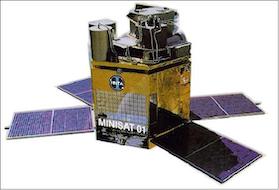Minisat-1 (LEGRI)

The Minisat-1 mission was a Spanish-led mission
with a primary instrument being the Low Energy Gamma-ray Imager (LEGRI), a
coded masked prototype instrument. The satellite was launched on April 21, 1997
from a Pegasus XL rocket (a “winged” rocket dropped from an
aircraft)
and the LEGRI instrument onboard was activated on
May 19, 1997. The instrument was a collaboration between the University of
Valencia, University of Alicante, Centro de Investigaciones Energeticas,
Medioambientales y Technologicas (CIEMAT), Instituto Nacional de Technica
Aerospacial (INTA), University of Southampton, University of Birmingham, and
the Rutherford Appleton Laboratory.
Minisat-1 was the first operational mission in the Minisat series. It was
planned with a two year mission span, but ultimately operated sucessfully for
five years before re-entry into the Earth’s atmosphere.
LEGRI was not the only instrument on MiniSat-1, but is the primary one of
interest to high-energy astrophysics.
LEGRI was a coded mask array gamma ray detector. The detector plane was a
mosaic of 10 x 10 of 80 HgI2 and 20 CdZnTe crystals 0.5 cm thick
with an active area of 1 cm2: the mixed detectors were intended to
test differing technologies under identical conditions. The detector was
passively shielded on the back and sides by the mechanical assembly and by a
tantalum collimator and aluminium window in the pointing direction. The coded
mask was mounted 540 mm in front of the instrument and was made of tungsten
elements attached to a honeycomb plate and support structure. A start sensor
allowed precise tracking of attitude of the spacecraft to permit ground-based
analysis without blurring from spacecraft motion. The instrument has a spatial
resolution of 20 arcminutes, and could perform moderate spectroscopy (with
4 keV resolution at 30 eV).
LEGRI was primarily a proof-of-concept mission for coded-mask
gamma-ray imaging. Having shown the concept worked, LEGRI detected and
characterized gamma-ray burst sources in particular.
[Publications]
[All Missions]
[by Time]
[by Energy]
Page authors: Lorella Angelini Jesse Allen
HEASARC Home |
Observatories |
Archive |
Calibration |
Software |
Tools |
Students/Teachers/Public
Last modified: Thursday, 24-Sep-2020 17:21:49 EDT
|